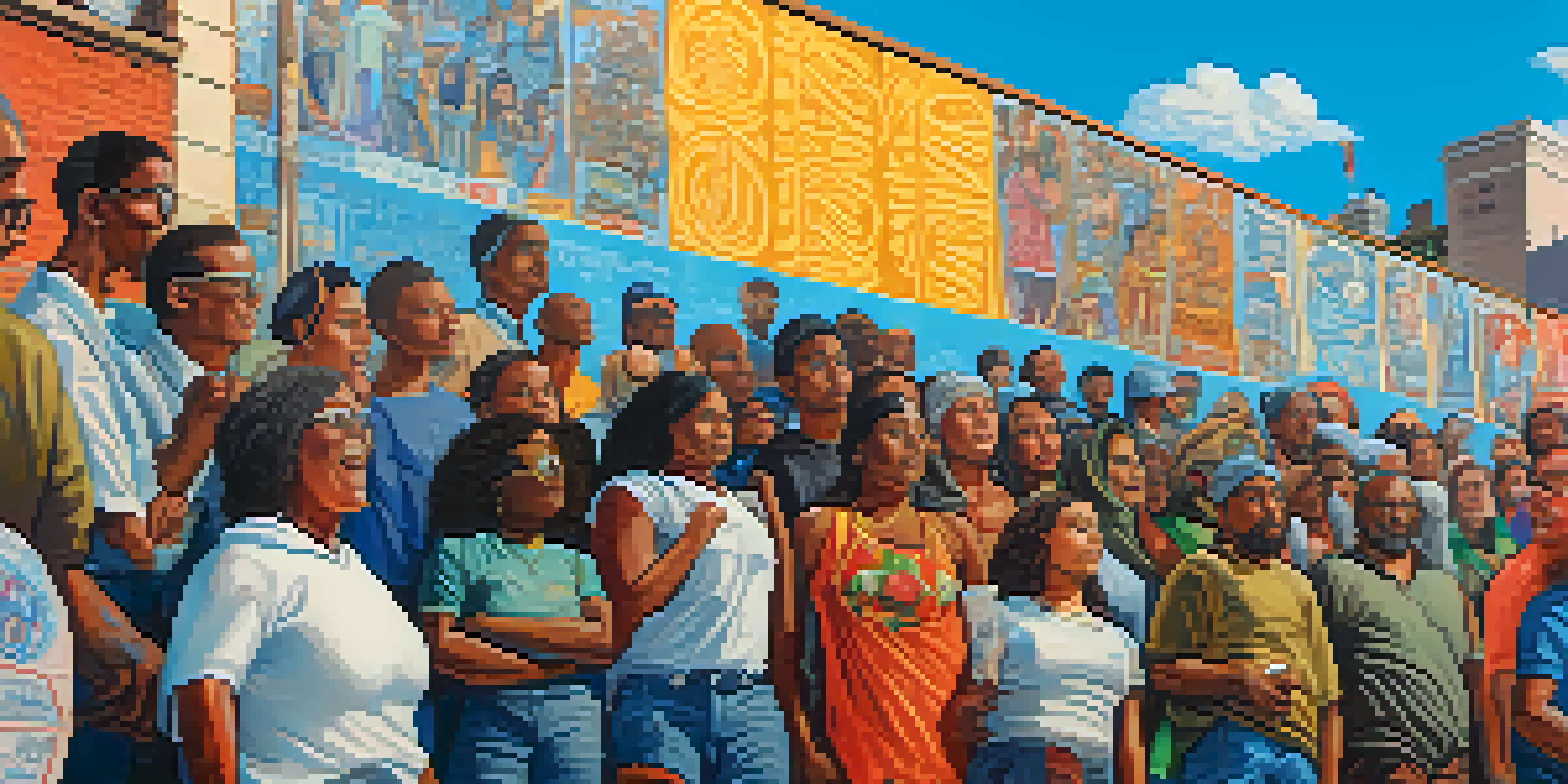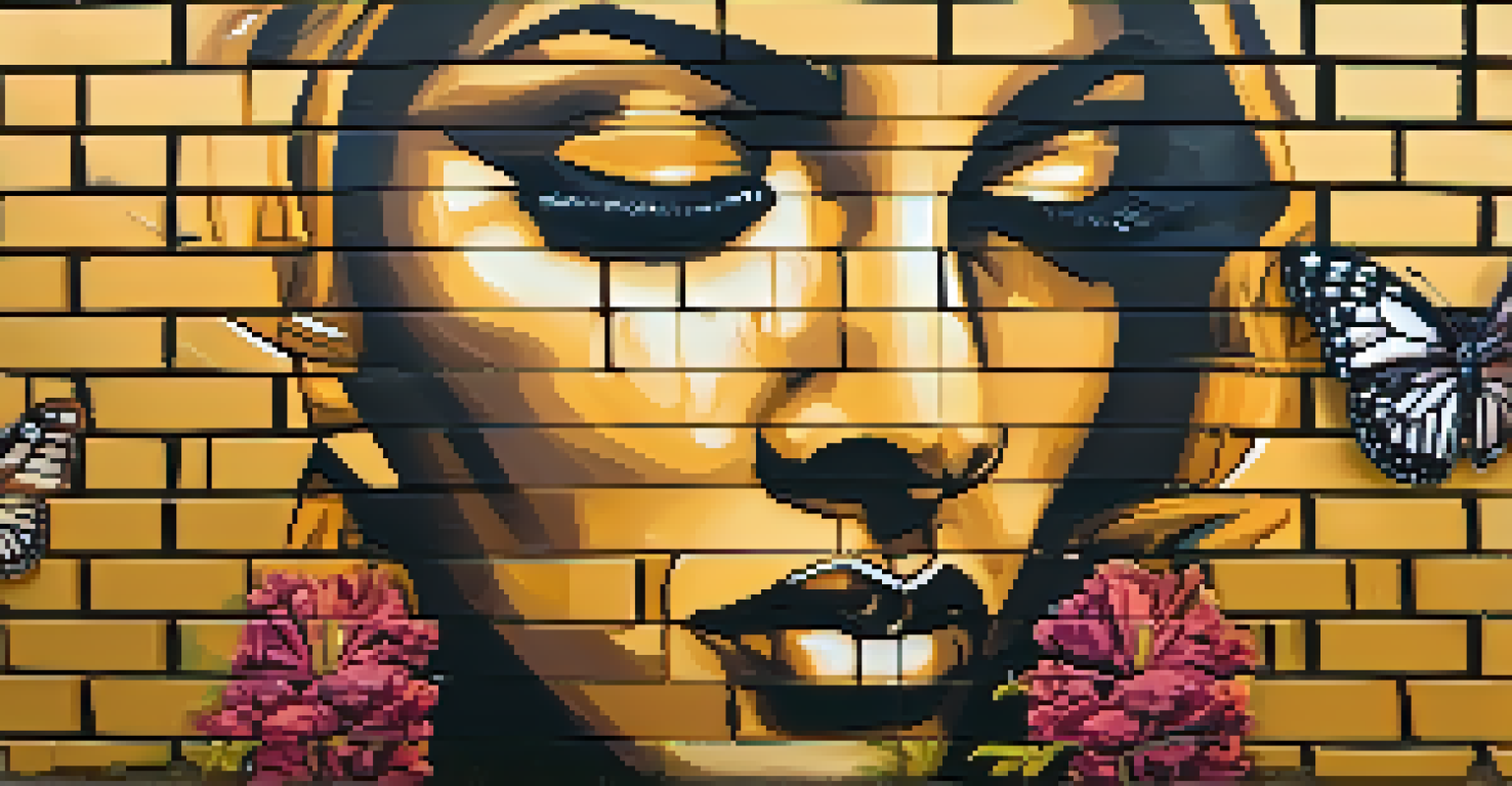The Influence of Social Activism on Contemporary Art

Understanding Social Activism in the Art World
Social activism, at its core, is about advocating for change and raising awareness on pressing societal issues. In the realm of art, this means using creative expression to challenge the status quo and provoke thought. Artists have often found inspiration in social movements, turning their canvases into platforms for dialogue and reflection.
Art is not a mirror held up to reality, but a hammer with which to shape it.
From civil rights to climate change, artists are now more than ever leveraging their work to comment on societal challenges. This intersection of art and activism is not just a trend but a powerful response to the world's complexities. It invites both artists and audiences to engage in meaningful conversations that transcend mere aesthetics.
By understanding social activism as a form of art, we can appreciate how it mirrors the struggles and triumphs of society. This symbiotic relationship enriches both the art itself and the movements it represents, creating a vibrant tapestry of cultural critique and inspiration.
Historical Context of Activism in Art
The roots of social activism in art can be traced back to various historical movements, where artists played pivotal roles in societal change. For instance, the Dada movement emerged as a reaction to World War I, using absurdity to critique nationalism and materialism. Similarly, the Harlem Renaissance highlighted African American culture and social justice through vibrant artistic expressions.

These historical precedents set the stage for contemporary artists, who draw upon past struggles to inform their work. They use the lessons learned from earlier movements to address current issues, making art a continuous dialogue across generations. This historical context not only enriches the narrative but also reinforces the idea that art is a living response to the world around us.
Art as a Catalyst for Change
Artists leverage their work to comment on societal challenges, turning their creative expression into a platform for meaningful dialogue.
By looking back, we see how artists have always been at the forefront of social change, challenging norms and advocating for justice. This legacy empowers today's creators to push boundaries and inspire audiences to think critically about the world they inhabit.
Prominent Contemporary Activist Artists
Today, many artists are known not only for their aesthetic contributions but also for their commitment to social causes. Figures like Ai Weiwei and Banksy have become synonymous with activism, using their platforms to address issues such as human rights and consumerism. Their works are often provocative, designed to spark dialogue and inspire action.
The role of the artist is to make the revolution irresistible.
These artists employ various mediums, from installations to street art, to convey their messages. For instance, Ai Weiwei's installations often reflect political dissent, while Banksy's graffiti critiques consumer culture and social inequality. Their ability to blend art with activism has made them influential figures in contemporary society.
By examining their work, we can see how art can serve as both a mirror and a hammer—reflecting societal issues while also shaping perceptions and prompting change. This duality is what makes contemporary activist art so impactful and relevant.
The Role of Art Institutions in Activism
Art institutions, such as galleries and museums, play a significant role in amplifying activist art. They provide platforms for artists to showcase their work and engage with broader audiences. By curating exhibits that focus on social issues, these institutions can educate the public and foster critical dialogue.
In recent years, many art institutions have embraced social activism, hosting exhibitions that highlight marginalized voices and pressing global issues. This shift reflects a growing recognition of the power of art as a tool for social change. Institutions are beginning to understand their responsibility to support artists who tackle difficult subjects.
Historical Influence on Modern Art
Contemporary artists draw inspiration from historical movements, using lessons learned to address current social issues and provoke thought.
However, this involvement is not without challenges. Balancing commercial interests with the mission of social justice can be tricky, and institutions must navigate these waters carefully. Ultimately, when done right, the collaboration between art and institutions can lead to transformative experiences for both artists and audiences.
Digital Platforms and Social Media's Impact
The rise of digital platforms and social media has revolutionized how art and activism intersect. Artists can now share their work with a global audience instantly, bypassing traditional gatekeepers like galleries and museums. This democratization of art allows for a wider range of voices and perspectives to be heard.
Social media, in particular, has become a powerful tool for activist artists. Platforms like Instagram and TikTok enable artists to not only showcase their work but also engage with followers in real-time. This interaction fosters a sense of community and encourages collective action around social issues.
Moreover, the viral nature of social media campaigns can propel an artist's message far beyond their immediate circle. This ability to reach a larger audience amplifies the impact of their work, making social media an essential component of contemporary art activism.
Challenges Faced by Activist Artists
While the intersection of art and activism is vibrant, it's not without its challenges. Many activist artists face resistance from institutions, critics, or even the public. Navigating these obstacles can be daunting, especially when their messages provoke discomfort or challenge deeply held beliefs.
Additionally, funding and support can be significant hurdles for these artists. Many rely on grants, crowdfunding, or community support to create their work. The financial instability can limit their ability to produce art that addresses urgent social issues, forcing them to compromise their vision.
Challenges for Activist Artists
Despite their passion for change, activist artists often face obstacles such as funding issues and resistance from institutions or the public.
Despite these challenges, many artists persevere, driven by their passion for change and commitment to their causes. Their resilience is a testament to the transformative power of art and its capacity to inspire action, even in the face of adversity.
The Future of Activism in Contemporary Art
Looking ahead, the relationship between social activism and contemporary art is likely to evolve further. As societal issues become more complex, artists will continue to explore innovative ways to engage with these challenges. We may see the emergence of new mediums and platforms that push the boundaries of traditional art forms.
Moreover, the increasing focus on sustainability and inclusivity will shape the narratives of future activist art. Artists are already responding to climate change and social justice issues in unique ways, and this trend is expected to grow. Collaborations across disciplines—like art, science, and technology—will likely create fresh perspectives and solutions.

Ultimately, the future of activism in art holds immense potential. As artists continue to challenge conventions and inspire change, their work will not only reflect the world around us but also catalyze transformation within it.